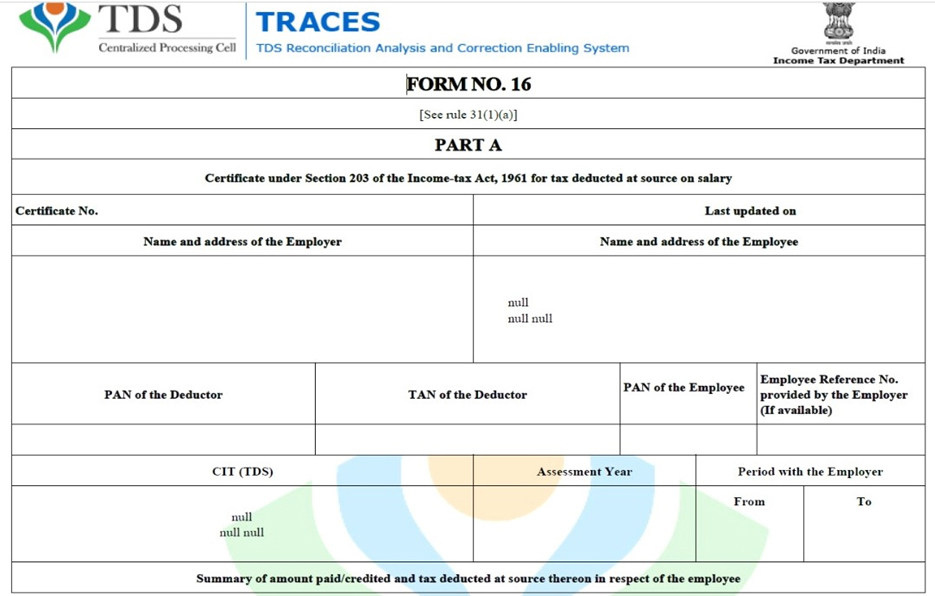Form 16 is a TDS certificate that shows the salary earned and the TDS deducted from your salary. It is issued by the employer before June 15th every year, after the end of the financial year in which the income was earned. Keep in mind that you should receive Form 16 from all the employers you have worked with.
Form 16 plays a very important role when it comes to filing income tax returns for salaried individuals. It has two components: Part A and Part B.

What is Form 16?
Form 16 is a certificate issued to salaried employees by their employer that provides a detailed summary of TDS deducted and deposited to the Income tax authorities. Form 16 is an important document issued under the Income Tax Act of 1961 provisions.
Each salaried employee can obtain Form 16 from the employer on or before the 15th of June of the following year, immediately after the financial year in which the tax is deducted. If any employer delays or fails to issue Form 16 by the specified date, he is liable to pay a penalty of Rs.100 per day until the default continues.
Employers are required to issue Form 16 to their salaried employees on or before the 15th of June of the assessment year for which the income tax return is being filed. For example, for the financial year 2023-24 (assessment year 2024-25), Form 16 should be issued by 15th June 2024.
Types of Form 16
There are two types of Form 16: Form 16A and Form 16B. Both are related to Tax Deducted at Source (TDS), but they serve different purposes. Here is what each form is used for:
Form 16A: Form 16A is a certificate for Tax Deducted at source (TDS) and is provided along with Form 16. Both Form 16 & 16A are TDS certificates, but Form 16 is for individuals who receive income from salary. On the other hand, Form 16A is for all incomes other than salary.
Form 16B: Form 16B is a certificate of tax deducted on the purchase of property; TDS under section 194IA is required to be deducted when a person buys an immovable property for consideration greater than 50 lakhs of rupees. In such a case, the buyer will be required to deduct the TDS of the seller and file form 26QB; after filing 26QB, form 16B will be generated, which serves the basic purpose of the TDS certificate depicting the basic details of the buyer and seller of property and consideration and amount of TDS deduction.
What are the Components of Form 16?
Part A:
This section contains details such as the employer’s and employee’s PAN (Permanent Account Number), employer’s TAN (Tax Deduction and Collection Account Number), summary of tax deducted and deposited by the employer (TDS), and other relevant details.
Part A consists of the following –
- Name and Address of the employer
- PAN and TAN of the employer
- Employee’s PAN
- Quarterly summary of total salary payments for the relevant FY.
- Summary of quarterly tax deducted and deposited as certified by the employer.
Part B:
Part B provides a more detailed picture of your income like the employee’s salary, allowances, deductions claimed by the employee (such as under Section 80C, 80D, etc.), and the resultant taxable income. It is an annexure to part A. It also includes details of income from other sources, if any.
Some constituents of Part B are –
- Detailed breakup of salary
- Detailed breakup of allowances exempted under section 10
- Deductions allowed under the IT Act under Chapter VI-A
- TDS deducted by the employer
What is Form 16A?
Form 16A is also a TDS Certificate. While Form 16 is for only salary income, Form 16A is applicable for TDS on ‘Income Other than Salary’.
For example, a Form 16A shall be issued to you – when a bank deducts TDS on your interest income from fixed deposits, for TDS deducted on insurance commission, for TDS deducted on your rent receipts. In fact, when TDS is deducted from any other income you receive, that is liable for such deduction.
This certificate also has details of the name and address of the deductor/deductee, PAN/TAN details, and challan details of the TDS deposited. It also has details of income you have earned and the TDS deducted and deposited on such income. All details that are there in Form 16A are available on Form 26AS.
What are the Components of Form 16A?
Form 16A includes details like:
- Employer’s name, PAN and TAN
- Employee’s name, PAN and TAN
- Payment details
- TDS payment number
- Date of deposit and deposited tax amount
These details are also available in Form 26AS.
Difference between Form 16 and Form 16A
Parameters | Form 16 | Form 16A |
Eligibility | Individuals with salary | Professionals and self-employed individuals |
Issuer | The employer | Financial institutions, tenants, banks, etc. |
Issued against | salaried individuals | Non-salaried |
Issuance frequency | Annual | Quarterly |
Applies to | Salary Income | Income from Rent, professional charges, commission agents, hired machinery, etc. |
Law | Section 203 of the Income Tax Act | Section 203 of the Income Tax Act |
What is the Use of Form 16 in Income Tax Return Filing?
Form 16 serves as a vital document for salaried individuals when filing their income tax returns. It provides key information about the employee’s salary, TDS, and deductions. It shows the breakup of salary income and the TDS amount deducted by the employer. The details from Form 16 need to be accurately filled in the relevant sections of the income tax return form. There are certain details that need to be derived from Form 16 while filing ITR. Here is the information required –
- Exempted allowances under section 10
- Break down of deductions under section 16
- Taxable salary
- Income from house property reported by an employee and offered for TDS
- Income under ‘Other sources’ offered for TDS
- Section 80C deductions in detail
- Aggregate of section 80C deductions
- Tax payable or refund due.
Why is Form 16 required?
- Proof of Income and Tax Paid: Form 16 is a certificate provided by an employer to an employee, showing the salary paid during the financial year and the tax deducted at source (TDS) on that salary. It is proof that the employer has deducted and paid the tax on behalf of the employee.
- Income Tax Return (ITR) Filing: Form 16 simplifies the process of filing an income tax return. It provides a summary of the employee’s earnings and the tax deducted, making it easier to calculate taxable income and claim deductions.
- Documentation for Financial Purposes: It can be used as proof of income when applying for loans, credit cards, or other financial services.
- Verification by Tax Authorities: If the income tax department has any queries or discrepancies in the income tax return, Form 16 serves as an official document that provides the necessary details of salary and TDS.
- Compliance with Tax Laws: It helps employees and employers ensure compliance with tax laws and regulations, as the form reflects accurate and timely payment of taxes.
FAQs
I haven’t received Form 16; how do I calculate my Salary Income?
If you haven’t received Form 16, you will have to refer to your salary payslips, bank statements, tax-saving investment proofs, home loan certificates, education loan certificates, Form 26AS, etc., for filing income tax returns. While payslips contain details of your income, like basic salary and allowances, Form 26AS contains the details of all your taxes deducted and taxes paid.
How to rectify errors in Form 16?
If there is any error in Form 16 because of the employer’s mistake, then the same can be rectified by your employer at your request. Subsequently, a revised Form 16 will be issued to you by your employer. Provide them with the necessary details and documentation to support your claim. They will rectify the errors and issue a corrected Form 16.
